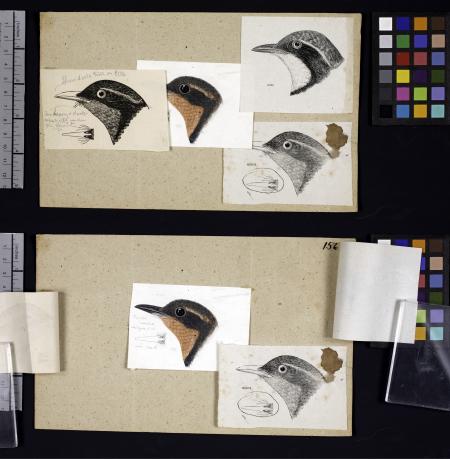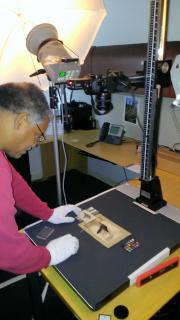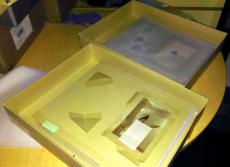
Back in September, the Archives decided to begin its first rapid capture digitization pilot project. Since the point of rapid capture is to significantly increase throughput in digitization of material, having a group of material that is all relatively the same size is important. Robert Ridgway’s bird head drawings, contained in Record Unit 7167, Series 3, were identified as a possible candidate for rapid capture based on the uniform size of all the drawings and digitization priorities within the Archives.
After the series was chosen, the next step in determining whether or not it was a good candidate for rapid capture was meeting with our conservation team to assess the condition of the drawings. When the collection was rehoused several years ago, the drawings were all placed in sink mats with flexible Mylar corners that have helped them remain in pretty good condition over time. Our conservators identified a handful of material that needed to be treated prior to being imaged, and once that work was completed, we were ready to begin the imaging process.
 Since we were imaging non-bound materials using a copy stand setup, the workflow required two people to make it run smoothly; one to transfer each drawing to and from the copy stand, and one to take care of placing the image and taking the picture. Since the drawings would need to be taken out of their Mylar corners before being imaged, and then placed back within them once imaging was complete, we were initially worried that a third person might be needed in order to keep the process moving along at a rapid pace. However, after consulting with the conservation team, since the materials were housed in sink mats, we were able to place the drawings on top of the Mylar corners within the mats and then cover each mat with a sheet of tissue to avoid disrupting the images below when the mat above it was moved. This allowed us to prepare several boxes prior to each imaging session. The drawings were placed back in the Mylar corners after they were imaged, but since this step of the rehousing process only took a few seconds, it was completed as the next image was taken.
Since we were imaging non-bound materials using a copy stand setup, the workflow required two people to make it run smoothly; one to transfer each drawing to and from the copy stand, and one to take care of placing the image and taking the picture. Since the drawings would need to be taken out of their Mylar corners before being imaged, and then placed back within them once imaging was complete, we were initially worried that a third person might be needed in order to keep the process moving along at a rapid pace. However, after consulting with the conservation team, since the materials were housed in sink mats, we were able to place the drawings on top of the Mylar corners within the mats and then cover each mat with a sheet of tissue to avoid disrupting the images below when the mat above it was moved. This allowed us to prepare several boxes prior to each imaging session. The drawings were placed back in the Mylar corners after they were imaged, but since this step of the rehousing process only took a few seconds, it was completed as the next image was taken.
 The number of images taken per box varied because, while all of the boxes contained the same number of sink mats, many of the drawings contained overlapping pieces of paper which required multiple photographs in order to capture all of the content. However, on average, it took about thirty minutes to complete each box, regardless of the number of images taken. During the rapid capture process, great care was taken to make sure that all of the drawings for a given box were captured in the same spot so that the raw files could be post-processed in bulk rather than having to crop each file individually.
The number of images taken per box varied because, while all of the boxes contained the same number of sink mats, many of the drawings contained overlapping pieces of paper which required multiple photographs in order to capture all of the content. However, on average, it took about thirty minutes to complete each box, regardless of the number of images taken. During the rapid capture process, great care was taken to make sure that all of the drawings for a given box were captured in the same spot so that the raw files could be post-processed in bulk rather than having to crop each file individually.
All in all, rapid capture allowed us to produce over 1100 images from 29 boxes of drawings. The overlapping pieces of paper on many of the drawings would have made it difficult to digitize the drawings on a traditional flatbed scanner without causing harm to the material, but using the copy stand allowed us to significantly reduce the strain placed on the drawings. We hope to link the images produced during this pilot project to the collection’s finding aid sometime in the near future. The next set of material we plan on digitizing via rapid capture is Series 4 of Robert Ridgway’s papers.
Related Resources
- Meet Robert Ridgway, Ornithologist and Artist, The Bigger Picture blog, Smithsonian Institution Archives
Related Collections
- Record Unit 7167, Ridgway, Robert 1850-1929, Robert Ridgway Papers, circa 1850s-1919, Smithsonian Institution Archives
Produced by the Smithsonian Institution Archives. For copyright questions, please see the Terms of Use.

Leave a Comment